Macroeconomics Report: Analysis of the 2019-20 Australian Budget
VerifiedAdded on 2023/03/17
|9
|1940
|23
Report
AI Summary
This report analyzes the 2019-20 Australian Federal Government budget, focusing on key macroeconomic challenges such as financial problems, unemployment, housing affordability, and the gap between rich and poor. It examines the government's fiscal policies, including funding for housing, skills development, and tax relief, and their impact on unemployment and the cost of living. The report explores the budget's aim to reduce national debt through fiscal and monetary policies. It also presents an analysis of the budget surplus and its positive effects on GDP, employment, and interest rates. The report further utilizes economic models like the Keynesian Cross, IS-LM, budget line, and AD-AS model to illustrate the budget's effects on aggregate expenditure, demand, and supply. The analysis includes relevant diagrams and references to support the findings.
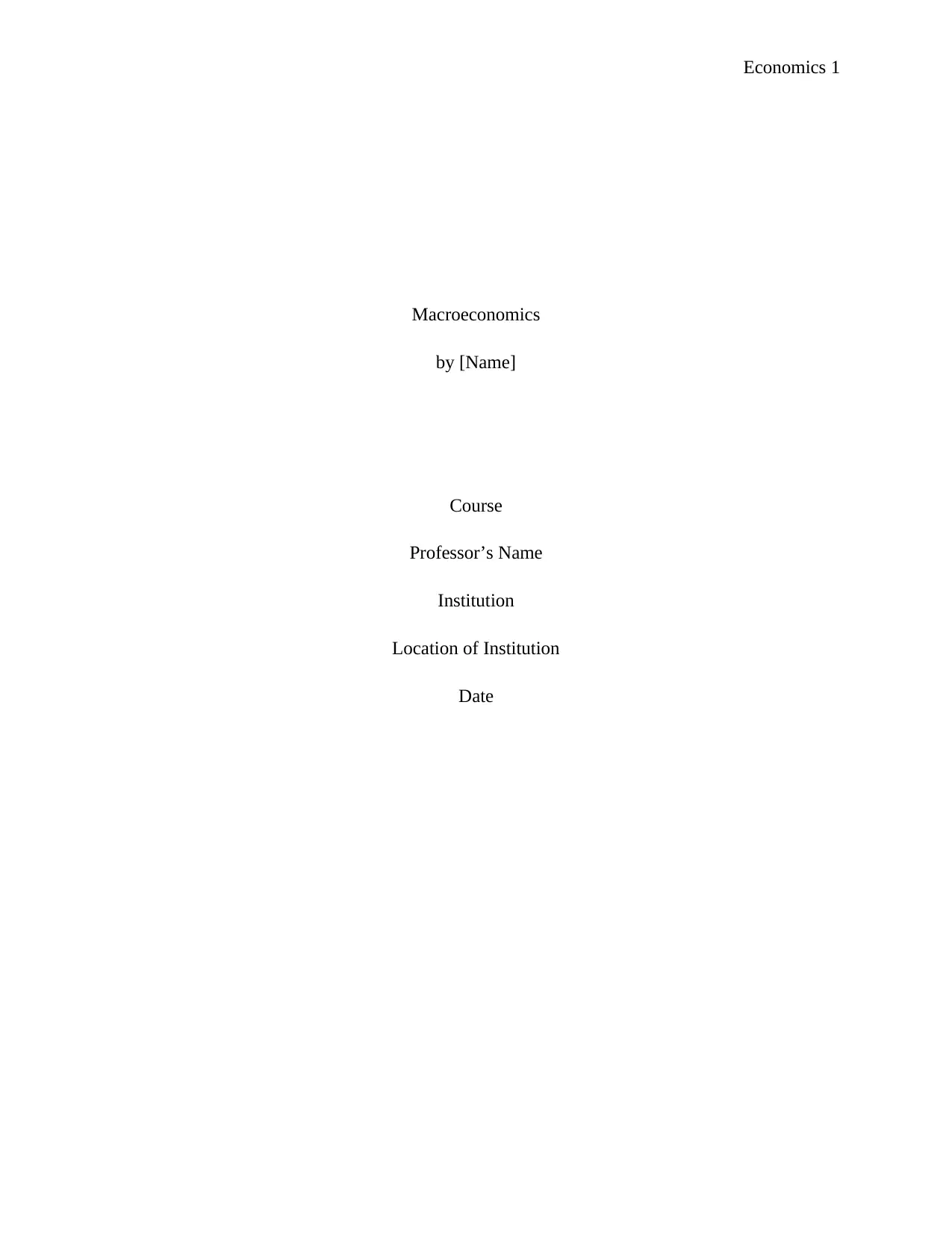
Economics 1
Macroeconomics
by [Name]
Course
Professor’s Name
Institution
Location of Institution
Date
Macroeconomics
by [Name]
Course
Professor’s Name
Institution
Location of Institution
Date
Paraphrase This Document
Need a fresh take? Get an instant paraphrase of this document with our AI Paraphraser
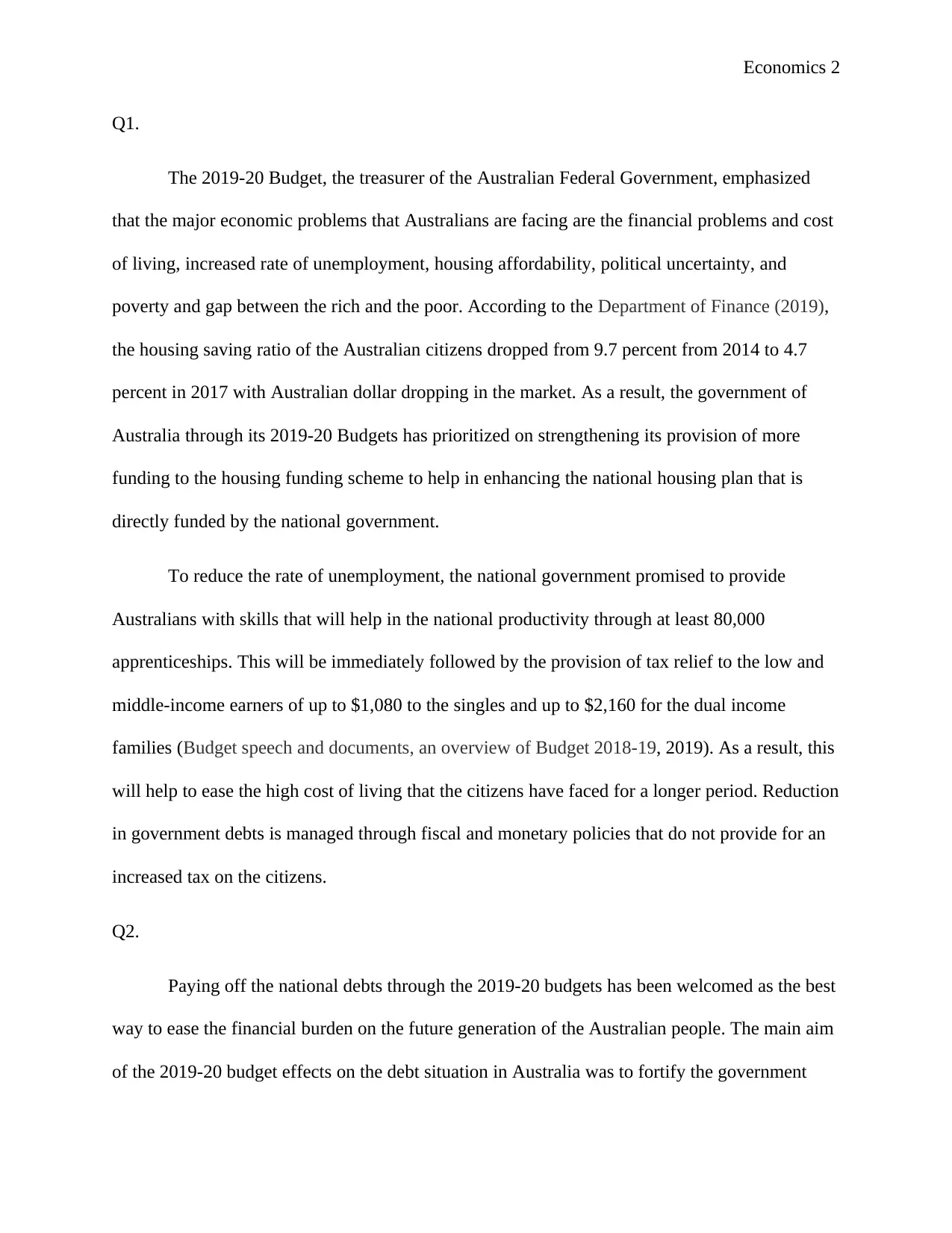
Economics 2
Q1.
The 2019-20 Budget, the treasurer of the Australian Federal Government, emphasized
that the major economic problems that Australians are facing are the financial problems and cost
of living, increased rate of unemployment, housing affordability, political uncertainty, and
poverty and gap between the rich and the poor. According to the Department of Finance (2019),
the housing saving ratio of the Australian citizens dropped from 9.7 percent from 2014 to 4.7
percent in 2017 with Australian dollar dropping in the market. As a result, the government of
Australia through its 2019-20 Budgets has prioritized on strengthening its provision of more
funding to the housing funding scheme to help in enhancing the national housing plan that is
directly funded by the national government.
To reduce the rate of unemployment, the national government promised to provide
Australians with skills that will help in the national productivity through at least 80,000
apprenticeships. This will be immediately followed by the provision of tax relief to the low and
middle-income earners of up to $1,080 to the singles and up to $2,160 for the dual income
families (Budget speech and documents, an overview of Budget 2018-19, 2019). As a result, this
will help to ease the high cost of living that the citizens have faced for a longer period. Reduction
in government debts is managed through fiscal and monetary policies that do not provide for an
increased tax on the citizens.
Q2.
Paying off the national debts through the 2019-20 budgets has been welcomed as the best
way to ease the financial burden on the future generation of the Australian people. The main aim
of the 2019-20 budget effects on the debt situation in Australia was to fortify the government
Q1.
The 2019-20 Budget, the treasurer of the Australian Federal Government, emphasized
that the major economic problems that Australians are facing are the financial problems and cost
of living, increased rate of unemployment, housing affordability, political uncertainty, and
poverty and gap between the rich and the poor. According to the Department of Finance (2019),
the housing saving ratio of the Australian citizens dropped from 9.7 percent from 2014 to 4.7
percent in 2017 with Australian dollar dropping in the market. As a result, the government of
Australia through its 2019-20 Budgets has prioritized on strengthening its provision of more
funding to the housing funding scheme to help in enhancing the national housing plan that is
directly funded by the national government.
To reduce the rate of unemployment, the national government promised to provide
Australians with skills that will help in the national productivity through at least 80,000
apprenticeships. This will be immediately followed by the provision of tax relief to the low and
middle-income earners of up to $1,080 to the singles and up to $2,160 for the dual income
families (Budget speech and documents, an overview of Budget 2018-19, 2019). As a result, this
will help to ease the high cost of living that the citizens have faced for a longer period. Reduction
in government debts is managed through fiscal and monetary policies that do not provide for an
increased tax on the citizens.
Q2.
Paying off the national debts through the 2019-20 budgets has been welcomed as the best
way to ease the financial burden on the future generation of the Australian people. The main aim
of the 2019-20 budget effects on the debt situation in Australia was to fortify the government
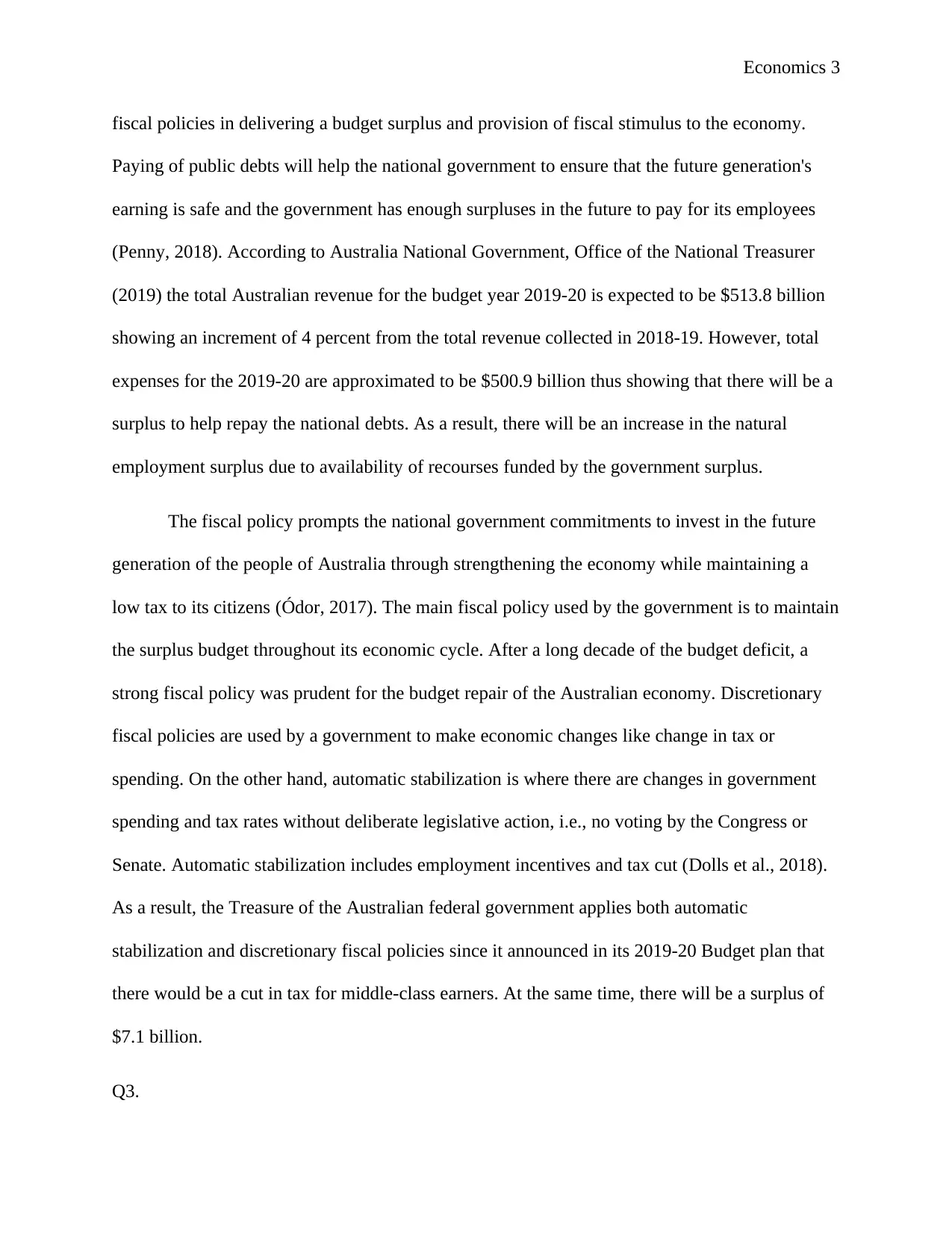
Economics 3
fiscal policies in delivering a budget surplus and provision of fiscal stimulus to the economy.
Paying of public debts will help the national government to ensure that the future generation's
earning is safe and the government has enough surpluses in the future to pay for its employees
(Penny, 2018). According to Australia National Government, Office of the National Treasurer
(2019) the total Australian revenue for the budget year 2019-20 is expected to be $513.8 billion
showing an increment of 4 percent from the total revenue collected in 2018-19. However, total
expenses for the 2019-20 are approximated to be $500.9 billion thus showing that there will be a
surplus to help repay the national debts. As a result, there will be an increase in the natural
employment surplus due to availability of recourses funded by the government surplus.
The fiscal policy prompts the national government commitments to invest in the future
generation of the people of Australia through strengthening the economy while maintaining a
low tax to its citizens (Ódor, 2017). The main fiscal policy used by the government is to maintain
the surplus budget throughout its economic cycle. After a long decade of the budget deficit, a
strong fiscal policy was prudent for the budget repair of the Australian economy. Discretionary
fiscal policies are used by a government to make economic changes like change in tax or
spending. On the other hand, automatic stabilization is where there are changes in government
spending and tax rates without deliberate legislative action, i.e., no voting by the Congress or
Senate. Automatic stabilization includes employment incentives and tax cut (Dolls et al., 2018).
As a result, the Treasure of the Australian federal government applies both automatic
stabilization and discretionary fiscal policies since it announced in its 2019-20 Budget plan that
there would be a cut in tax for middle-class earners. At the same time, there will be a surplus of
$7.1 billion.
Q3.
fiscal policies in delivering a budget surplus and provision of fiscal stimulus to the economy.
Paying of public debts will help the national government to ensure that the future generation's
earning is safe and the government has enough surpluses in the future to pay for its employees
(Penny, 2018). According to Australia National Government, Office of the National Treasurer
(2019) the total Australian revenue for the budget year 2019-20 is expected to be $513.8 billion
showing an increment of 4 percent from the total revenue collected in 2018-19. However, total
expenses for the 2019-20 are approximated to be $500.9 billion thus showing that there will be a
surplus to help repay the national debts. As a result, there will be an increase in the natural
employment surplus due to availability of recourses funded by the government surplus.
The fiscal policy prompts the national government commitments to invest in the future
generation of the people of Australia through strengthening the economy while maintaining a
low tax to its citizens (Ódor, 2017). The main fiscal policy used by the government is to maintain
the surplus budget throughout its economic cycle. After a long decade of the budget deficit, a
strong fiscal policy was prudent for the budget repair of the Australian economy. Discretionary
fiscal policies are used by a government to make economic changes like change in tax or
spending. On the other hand, automatic stabilization is where there are changes in government
spending and tax rates without deliberate legislative action, i.e., no voting by the Congress or
Senate. Automatic stabilization includes employment incentives and tax cut (Dolls et al., 2018).
As a result, the Treasure of the Australian federal government applies both automatic
stabilization and discretionary fiscal policies since it announced in its 2019-20 Budget plan that
there would be a cut in tax for middle-class earners. At the same time, there will be a surplus of
$7.1 billion.
Q3.
⊘ This is a preview!⊘
Do you want full access?
Subscribe today to unlock all pages.

Trusted by 1+ million students worldwide
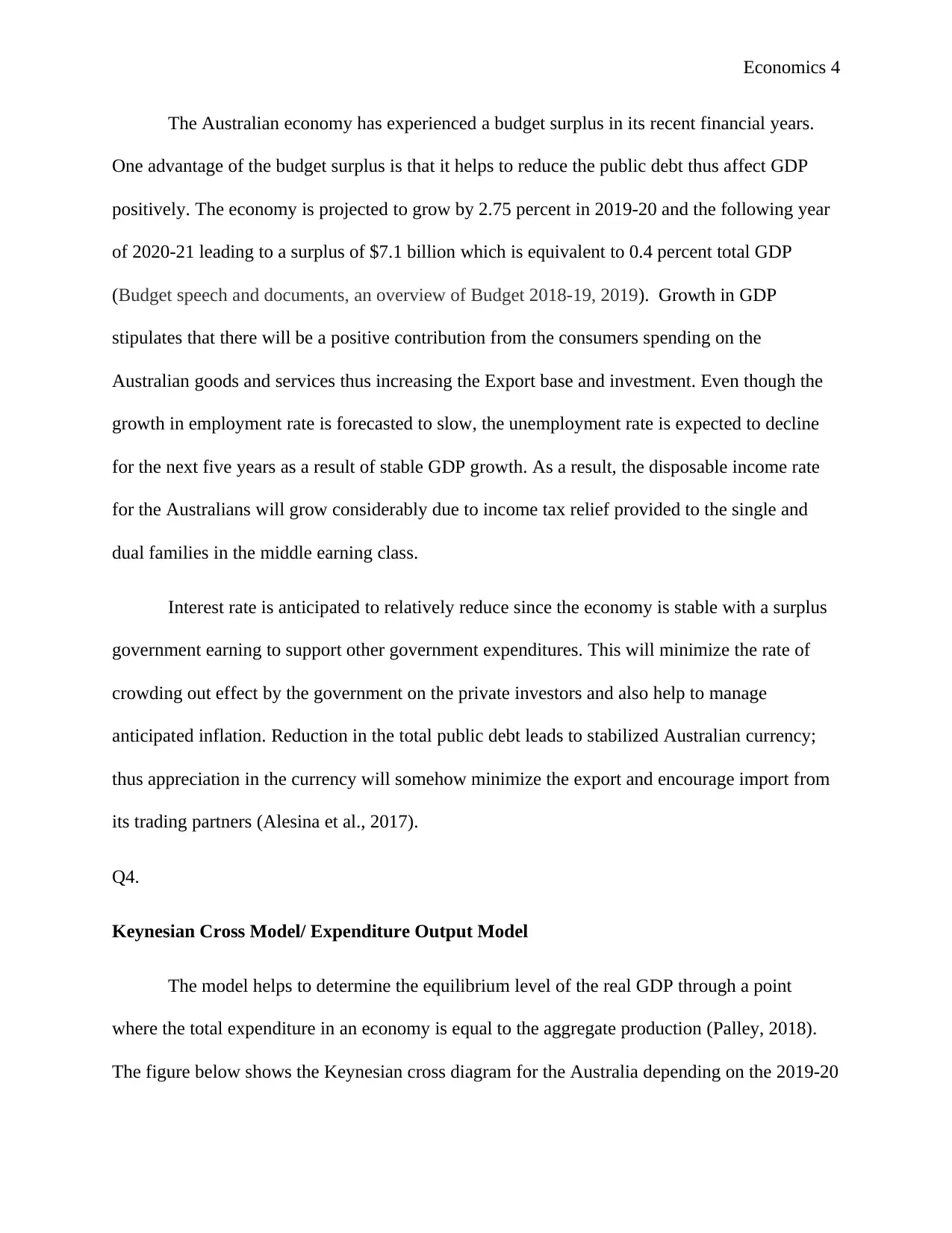
Economics 4
The Australian economy has experienced a budget surplus in its recent financial years.
One advantage of the budget surplus is that it helps to reduce the public debt thus affect GDP
positively. The economy is projected to grow by 2.75 percent in 2019-20 and the following year
of 2020-21 leading to a surplus of $7.1 billion which is equivalent to 0.4 percent total GDP
(Budget speech and documents, an overview of Budget 2018-19, 2019). Growth in GDP
stipulates that there will be a positive contribution from the consumers spending on the
Australian goods and services thus increasing the Export base and investment. Even though the
growth in employment rate is forecasted to slow, the unemployment rate is expected to decline
for the next five years as a result of stable GDP growth. As a result, the disposable income rate
for the Australians will grow considerably due to income tax relief provided to the single and
dual families in the middle earning class.
Interest rate is anticipated to relatively reduce since the economy is stable with a surplus
government earning to support other government expenditures. This will minimize the rate of
crowding out effect by the government on the private investors and also help to manage
anticipated inflation. Reduction in the total public debt leads to stabilized Australian currency;
thus appreciation in the currency will somehow minimize the export and encourage import from
its trading partners (Alesina et al., 2017).
Q4.
Keynesian Cross Model/ Expenditure Output Model
The model helps to determine the equilibrium level of the real GDP through a point
where the total expenditure in an economy is equal to the aggregate production (Palley, 2018).
The figure below shows the Keynesian cross diagram for the Australia depending on the 2019-20
The Australian economy has experienced a budget surplus in its recent financial years.
One advantage of the budget surplus is that it helps to reduce the public debt thus affect GDP
positively. The economy is projected to grow by 2.75 percent in 2019-20 and the following year
of 2020-21 leading to a surplus of $7.1 billion which is equivalent to 0.4 percent total GDP
(Budget speech and documents, an overview of Budget 2018-19, 2019). Growth in GDP
stipulates that there will be a positive contribution from the consumers spending on the
Australian goods and services thus increasing the Export base and investment. Even though the
growth in employment rate is forecasted to slow, the unemployment rate is expected to decline
for the next five years as a result of stable GDP growth. As a result, the disposable income rate
for the Australians will grow considerably due to income tax relief provided to the single and
dual families in the middle earning class.
Interest rate is anticipated to relatively reduce since the economy is stable with a surplus
government earning to support other government expenditures. This will minimize the rate of
crowding out effect by the government on the private investors and also help to manage
anticipated inflation. Reduction in the total public debt leads to stabilized Australian currency;
thus appreciation in the currency will somehow minimize the export and encourage import from
its trading partners (Alesina et al., 2017).
Q4.
Keynesian Cross Model/ Expenditure Output Model
The model helps to determine the equilibrium level of the real GDP through a point
where the total expenditure in an economy is equal to the aggregate production (Palley, 2018).
The figure below shows the Keynesian cross diagram for the Australia depending on the 2019-20
Paraphrase This Document
Need a fresh take? Get an instant paraphrase of this document with our AI Paraphraser
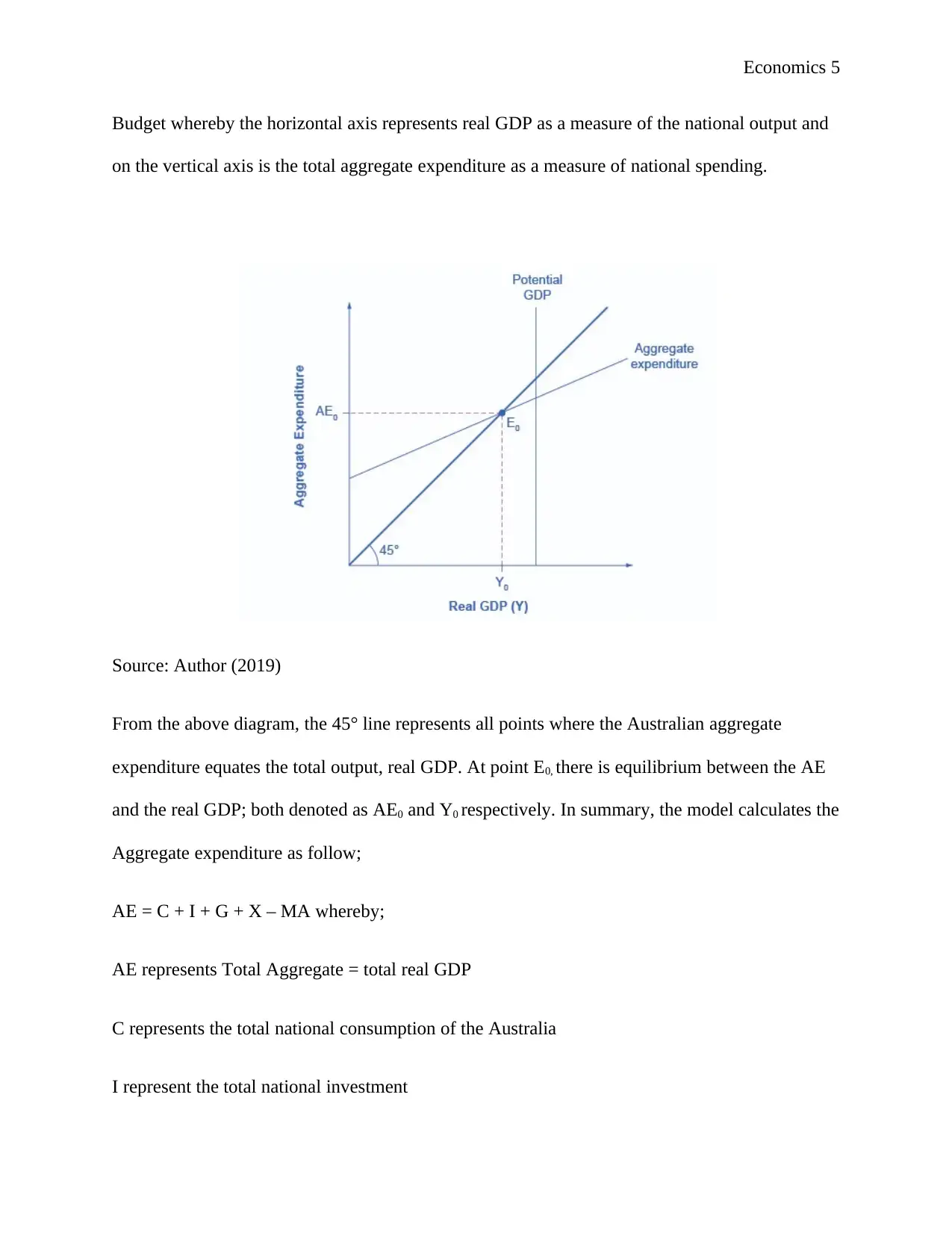
Economics 5
Budget whereby the horizontal axis represents real GDP as a measure of the national output and
on the vertical axis is the total aggregate expenditure as a measure of national spending.
Source: Author (2019)
From the above diagram, the 45° line represents all points where the Australian aggregate
expenditure equates the total output, real GDP. At point E0, there is equilibrium between the AE
and the real GDP; both denoted as AE0 and Y0 respectively. In summary, the model calculates the
Aggregate expenditure as follow;
AE = C + I + G + X – MA whereby;
AE represents Total Aggregate = total real GDP
C represents the total national consumption of the Australia
I represent the total national investment
Budget whereby the horizontal axis represents real GDP as a measure of the national output and
on the vertical axis is the total aggregate expenditure as a measure of national spending.
Source: Author (2019)
From the above diagram, the 45° line represents all points where the Australian aggregate
expenditure equates the total output, real GDP. At point E0, there is equilibrium between the AE
and the real GDP; both denoted as AE0 and Y0 respectively. In summary, the model calculates the
Aggregate expenditure as follow;
AE = C + I + G + X – MA whereby;
AE represents Total Aggregate = total real GDP
C represents the total national consumption of the Australia
I represent the total national investment
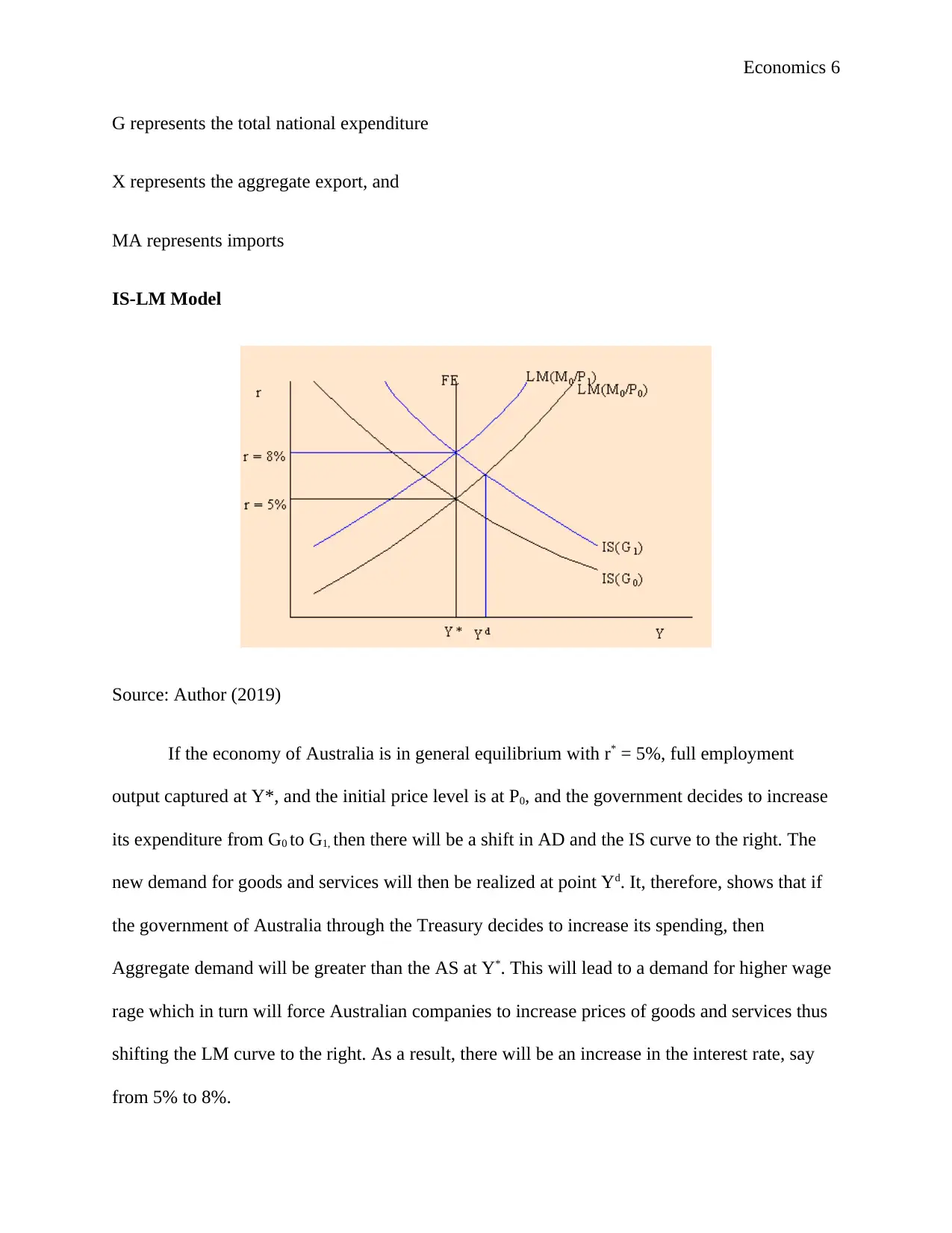
Economics 6
G represents the total national expenditure
X represents the aggregate export, and
MA represents imports
IS-LM Model
Source: Author (2019)
If the economy of Australia is in general equilibrium with r* = 5%, full employment
output captured at Y*, and the initial price level is at P0, and the government decides to increase
its expenditure from G0 to G1, then there will be a shift in AD and the IS curve to the right. The
new demand for goods and services will then be realized at point Yd. It, therefore, shows that if
the government of Australia through the Treasury decides to increase its spending, then
Aggregate demand will be greater than the AS at Y*. This will lead to a demand for higher wage
rage which in turn will force Australian companies to increase prices of goods and services thus
shifting the LM curve to the right. As a result, there will be an increase in the interest rate, say
from 5% to 8%.
G represents the total national expenditure
X represents the aggregate export, and
MA represents imports
IS-LM Model
Source: Author (2019)
If the economy of Australia is in general equilibrium with r* = 5%, full employment
output captured at Y*, and the initial price level is at P0, and the government decides to increase
its expenditure from G0 to G1, then there will be a shift in AD and the IS curve to the right. The
new demand for goods and services will then be realized at point Yd. It, therefore, shows that if
the government of Australia through the Treasury decides to increase its spending, then
Aggregate demand will be greater than the AS at Y*. This will lead to a demand for higher wage
rage which in turn will force Australian companies to increase prices of goods and services thus
shifting the LM curve to the right. As a result, there will be an increase in the interest rate, say
from 5% to 8%.
⊘ This is a preview!⊘
Do you want full access?
Subscribe today to unlock all pages.

Trusted by 1+ million students worldwide
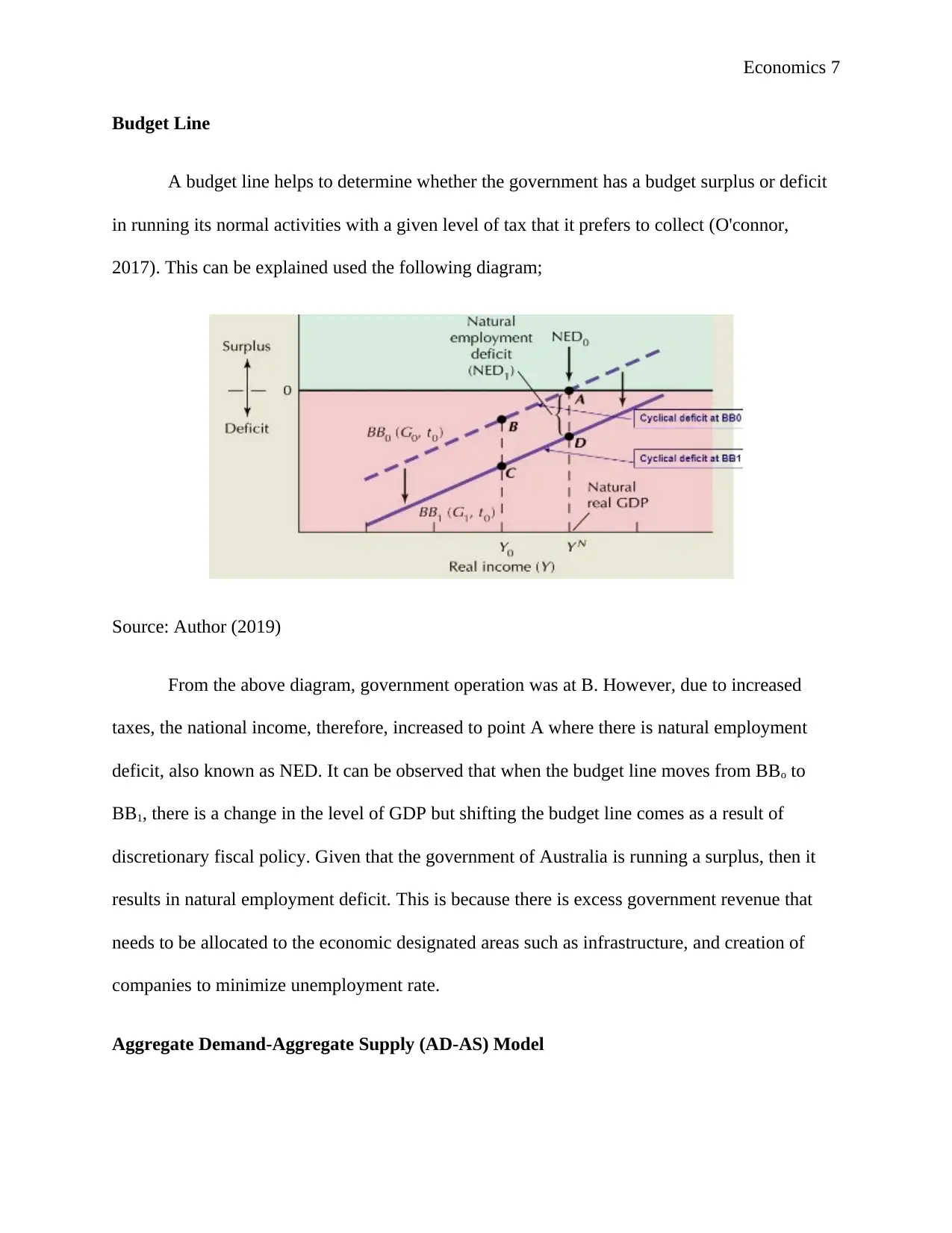
Economics 7
Budget Line
A budget line helps to determine whether the government has a budget surplus or deficit
in running its normal activities with a given level of tax that it prefers to collect (O'connor,
2017). This can be explained used the following diagram;
Source: Author (2019)
From the above diagram, government operation was at B. However, due to increased
taxes, the national income, therefore, increased to point A where there is natural employment
deficit, also known as NED. It can be observed that when the budget line moves from BBo to
BB1, there is a change in the level of GDP but shifting the budget line comes as a result of
discretionary fiscal policy. Given that the government of Australia is running a surplus, then it
results in natural employment deficit. This is because there is excess government revenue that
needs to be allocated to the economic designated areas such as infrastructure, and creation of
companies to minimize unemployment rate.
Aggregate Demand-Aggregate Supply (AD-AS) Model
Budget Line
A budget line helps to determine whether the government has a budget surplus or deficit
in running its normal activities with a given level of tax that it prefers to collect (O'connor,
2017). This can be explained used the following diagram;
Source: Author (2019)
From the above diagram, government operation was at B. However, due to increased
taxes, the national income, therefore, increased to point A where there is natural employment
deficit, also known as NED. It can be observed that when the budget line moves from BBo to
BB1, there is a change in the level of GDP but shifting the budget line comes as a result of
discretionary fiscal policy. Given that the government of Australia is running a surplus, then it
results in natural employment deficit. This is because there is excess government revenue that
needs to be allocated to the economic designated areas such as infrastructure, and creation of
companies to minimize unemployment rate.
Aggregate Demand-Aggregate Supply (AD-AS) Model
Paraphrase This Document
Need a fresh take? Get an instant paraphrase of this document with our AI Paraphraser

Economics 8
National aggregate demand comprises of the consumption, investment, government
expenditures, and Net export. Any change in these components leads to a shift in the AD as
shown in the figure below;
Source: Author (2019)
From the figure above, the national government of Australia can decide and apply its
fiscal policies in determining the level of national spending and taxes which can lead to a change
in the AD reflected in the shift of the AD curve to the right and the left as shown above. In the
2019-20 Budget, the national government of Australia reduced the income tax thus leaving the
consumers with more disposable income which led to an increase in consumption and saving
level. As a result, the AD curve shifted to the right. However, if the government spending
exceeds its collected taxes, then the expansionary policy will result into a budget deficit.
National aggregate demand comprises of the consumption, investment, government
expenditures, and Net export. Any change in these components leads to a shift in the AD as
shown in the figure below;
Source: Author (2019)
From the figure above, the national government of Australia can decide and apply its
fiscal policies in determining the level of national spending and taxes which can lead to a change
in the AD reflected in the shift of the AD curve to the right and the left as shown above. In the
2019-20 Budget, the national government of Australia reduced the income tax thus leaving the
consumers with more disposable income which led to an increase in consumption and saving
level. As a result, the AD curve shifted to the right. However, if the government spending
exceeds its collected taxes, then the expansionary policy will result into a budget deficit.
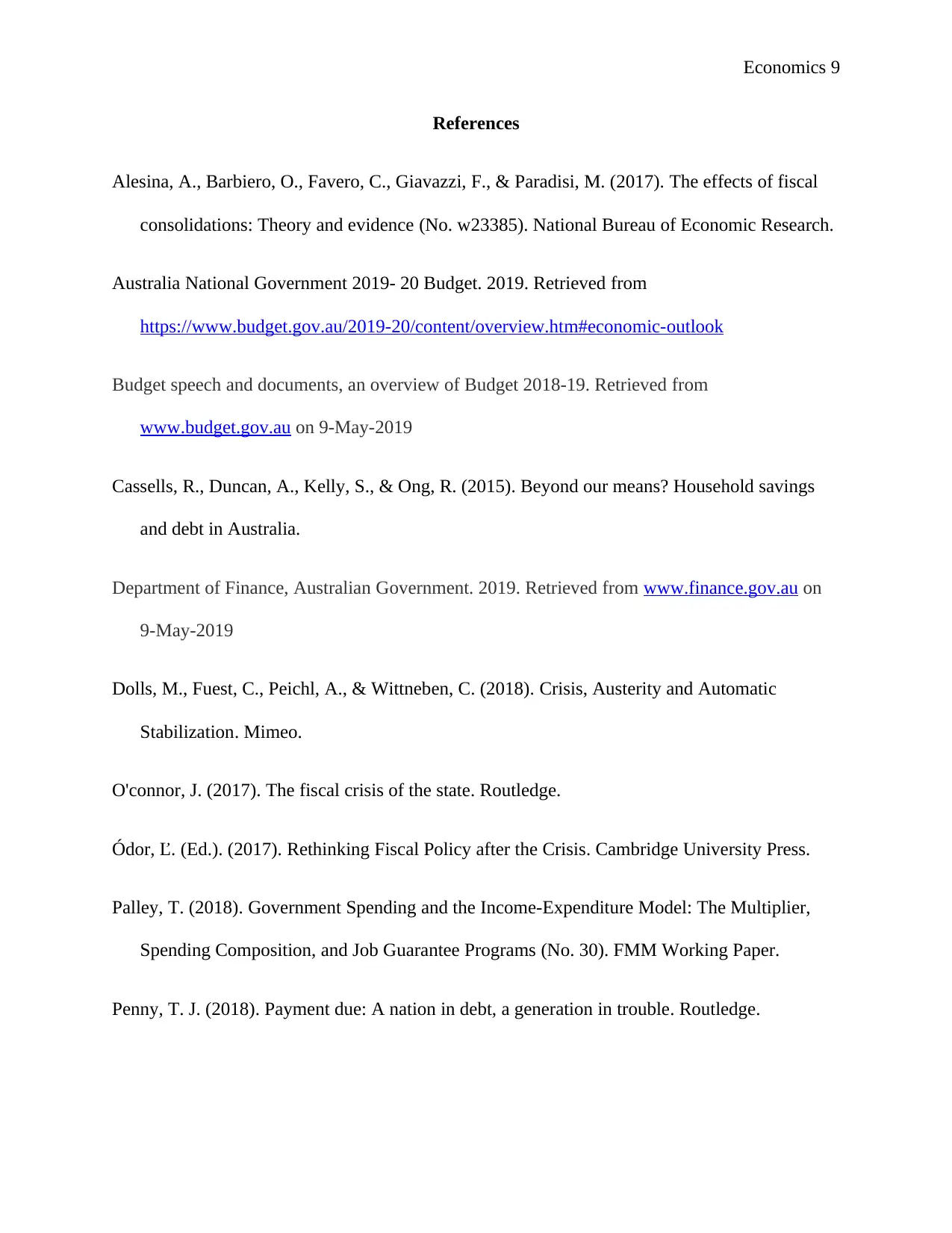
Economics 9
References
Alesina, A., Barbiero, O., Favero, C., Giavazzi, F., & Paradisi, M. (2017). The effects of fiscal
consolidations: Theory and evidence (No. w23385). National Bureau of Economic Research.
Australia National Government 2019- 20 Budget. 2019. Retrieved from
https://www.budget.gov.au/2019-20/content/overview.htm#economic-outlook
Budget speech and documents, an overview of Budget 2018-19. Retrieved from
www.budget.gov.au on 9-May-2019
Cassells, R., Duncan, A., Kelly, S., & Ong, R. (2015). Beyond our means? Household savings
and debt in Australia.
Department of Finance, Australian Government. 2019. Retrieved from www.finance.gov.au on
9-May-2019
Dolls, M., Fuest, C., Peichl, A., & Wittneben, C. (2018). Crisis, Austerity and Automatic
Stabilization. Mimeo.
O'connor, J. (2017). The fiscal crisis of the state. Routledge.
Ódor, Ľ. (Ed.). (2017). Rethinking Fiscal Policy after the Crisis. Cambridge University Press.
Palley, T. (2018). Government Spending and the Income-Expenditure Model: The Multiplier,
Spending Composition, and Job Guarantee Programs (No. 30). FMM Working Paper.
Penny, T. J. (2018). Payment due: A nation in debt, a generation in trouble. Routledge.
References
Alesina, A., Barbiero, O., Favero, C., Giavazzi, F., & Paradisi, M. (2017). The effects of fiscal
consolidations: Theory and evidence (No. w23385). National Bureau of Economic Research.
Australia National Government 2019- 20 Budget. 2019. Retrieved from
https://www.budget.gov.au/2019-20/content/overview.htm#economic-outlook
Budget speech and documents, an overview of Budget 2018-19. Retrieved from
www.budget.gov.au on 9-May-2019
Cassells, R., Duncan, A., Kelly, S., & Ong, R. (2015). Beyond our means? Household savings
and debt in Australia.
Department of Finance, Australian Government. 2019. Retrieved from www.finance.gov.au on
9-May-2019
Dolls, M., Fuest, C., Peichl, A., & Wittneben, C. (2018). Crisis, Austerity and Automatic
Stabilization. Mimeo.
O'connor, J. (2017). The fiscal crisis of the state. Routledge.
Ódor, Ľ. (Ed.). (2017). Rethinking Fiscal Policy after the Crisis. Cambridge University Press.
Palley, T. (2018). Government Spending and the Income-Expenditure Model: The Multiplier,
Spending Composition, and Job Guarantee Programs (No. 30). FMM Working Paper.
Penny, T. J. (2018). Payment due: A nation in debt, a generation in trouble. Routledge.
⊘ This is a preview!⊘
Do you want full access?
Subscribe today to unlock all pages.

Trusted by 1+ million students worldwide
1 out of 9
Related Documents
Your All-in-One AI-Powered Toolkit for Academic Success.
+13062052269
info@desklib.com
Available 24*7 on WhatsApp / Email
![[object Object]](/_next/static/media/star-bottom.7253800d.svg)
Unlock your academic potential
Copyright © 2020–2025 A2Z Services. All Rights Reserved. Developed and managed by ZUCOL.





